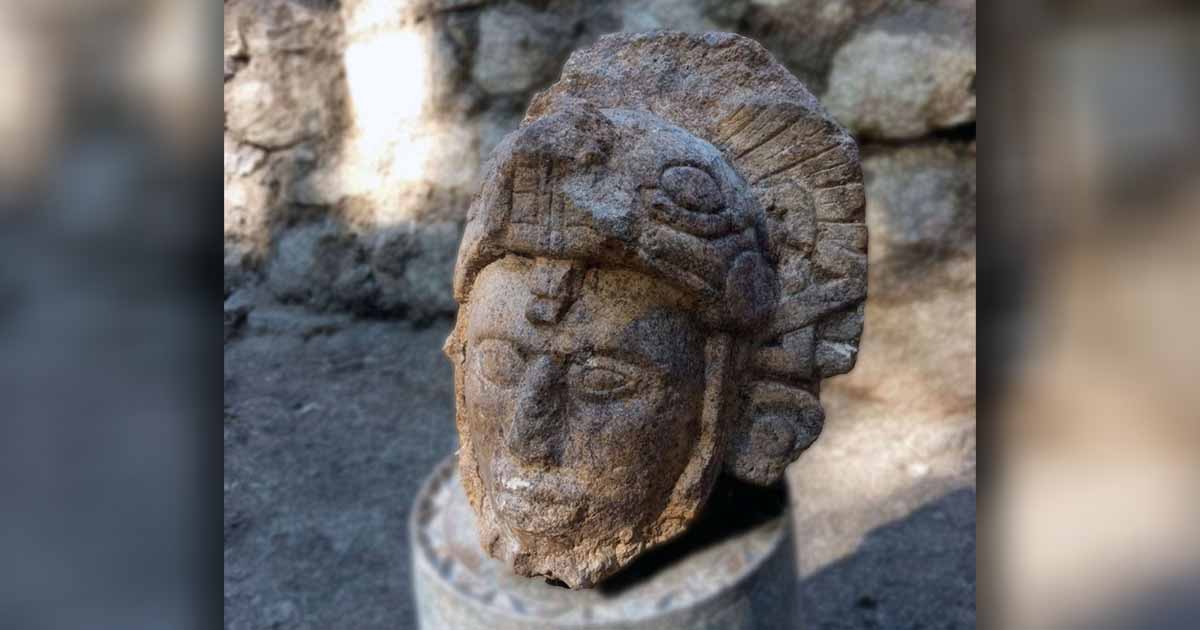Sculpted Maya Serpent Warrior Unearthed at Chichen Itza
Archaeologists digging at Mexico’s Chichen Itza were removing landfill from the Casa Colorada Complex when they made their remarkable discovery. Not only is this sculpted warrior wearing a feathered headdress, but he’s also depicted in a serpent helmet.
Mexico’s National Institute of Anthropology and History (INAH) has announced the findings from recent excavations at the Chichanchob, also known as the Casa Colorada Complex, this site is located near the ancient observatory, El Caracol, at the complex of Chichén Itzá, in the state of Yucatán, Mexico.
Inside this rectangular platform and temple, designed in the Puuc style, a chamber is adorned with intricately carved hieroglyphs depicting the lineage of rulers of Chichen Itza, and also the history of the rulers of nearby Ek Balam. The temple's interior hieroglyphs shows the date 869 AD, and Diego Prieto Hernández of INAH, recently announced the fascinating discovery of “a sculpted head” depicting a Maya warrior wearing a feather headdress and a serpent helmet.

Casa Colorada, Chichen Itza, Mexico. Source: Wangkun Jia / Adobe Stock.
A Maya Warrior Within A Serpent
Chichén Itzá rose to prominence in Mexico's Yucatan during the Late Classic and early Terminal Classic periods, and at its peak this ancient power centre encompassed around 10.36 square kilometers [4 square miles]. So vast was this trading hub that at its peak it supported a population of up to 35,000 residents.
Dated to the Late Classic period, the rare sculpted artifact was discovered during excavations by the Archaeological Areas Improvement Program (Promeza), in “Temple 6 of Maudslay,” which is part of the Casa Colorada complex of Chichén Itzá. The sculpted head of the Maya warrior measures approximately 33 centimeters (13 inches) in height by 28 centimeters (11 inches) in width. According to the INAH archaeologists, “the serpent helmet,” surrounding the sculpted warrior’s face is depicted with wide open jaws, and he also wears a feather headdress.
- Chichen Itza's Shadows: Unexpected Light Shed on Ancient Maya
- The ‘Myth’ of the Plumed Serpent: Revealing the Real Message Behind the Feathered Snake

Sculpted head of Maya serpent warrior. Credit: INAH
Serpent Mouth at The Well Of Itza
Chichen Itza means “ At the mouth of the well of the Itza”, a name which refers to the vast cenote that the city was built around. The three most renowned complexes Chichen Itza are the Great North Platform, including the Temple of Kukulcán (El Castillo), Temple of Warriors, and the Great Ball Court; the Osario Group, featuring the pyramid of the same name, and the Central Group.
In Maya culture, serpent warriors were participants in religious ceremonies who adorned themselves with serpent-themed attire. These warriors played a vital role in rituals associated with fertility and rain, acting as intermediaries between the earthly and supernatural realms. The intricate costumes, including headwear, reflected the Maya's craftsmanship, and the profound connections they forged between nature and spirituality.
Deciphering Serpent Symbolism
The creation of serpent, and jaguar headdresses, was a skilled artisanal practice, and the trade secrets were passed down through generations. Each headdress was a unique work of art, showcasing the craftsmanship and artistic prowess of the Maya, and the elaborate designs, with vibrant feathers, speak of the spiritual and ceremonial importance associated with serpents.
In Maya culture, serpent symbolism held profound significance, representing various interconnected concepts such as renewal, transformation, and cosmic energy. The serpent, often depicted in art and religious iconography, was a potent symbol of life cycles and the cyclical nature of existence. In Maya cosmology, the shedding of a serpent's skin became a metaphor for rebirth and regeneration, aligning with agricultural cycles and the renewal of nature.

Mayan relief carving depicting a warrior surrounded by serpents, Chichen Itza, Mexico. Source: frenta / Adobe Stock.
In addition to their positive connotations, serpents in Maya symbolism also represented the underworld and the supernatural realm. Moreover, serpents were associated with deities related to water, fertility, and rain, as the Maya believed serpent deities played a crucial role in sustaining life and ensuring agricultural abundance. While it is will never be known for sure, the chances are high that this feathered serpent represented “Kukulcán,” who was a prominent Maya deity symbolizing wisdom, knowledge, and the dualities of creation and destruction.
Top image: Sculpted head of Maya serpent warrior. Credit: INAH
By Ashley Cowie

















